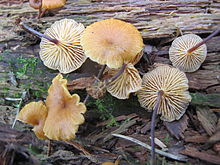Xeromphalina cauticinalis
| Xeromphalina cauticinalis | |
|---|---|

| |
| Scientific classification | |
| Domain: | Eukaryota |
| Kingdom: | Fungi |
| Division: | Basidiomycota |
| Class: | Agaricomycetes |
| Order: | Agaricales |
| Family: | Mycenaceae |
| Genus: | Xeromphalina |
| Species: | X. cauticinalis
|
| Binomial name | |
| Xeromphalina cauticinalis | |
| Synonyms[1] | |
| Xeromphalina cauticinalis | |
|---|---|
| Gills on hymenium | |
| Cap is convex or flat | |
| Hymenium is adnate or decurrent | |
| Stipe is bare | |
| Spore print is white | |
| Ecology is saprotrophic | |
| Edibility is inedible or unknown | |
Xeromphalina cauticinalis is a species of agaric fungus in the family Mycenaceae. Originally described in 1838 by Elias Fries as Marasmius cauticinalis, it was transferred to the genus Xeromphalina by Robert Kühner and René Maire in 1934.[1] It is found in North America, where it fruits in the summer and autumn singly or in groups on the seeds, needles, and sticks of conifers, and sometimes on aspen leaves. The fruit bodies have convex yellowish caps measuring 0.5–2.5 cm (0.2–1.0 in) in diameter supported by a tough yellow-brown to dark brown stipe that is 3–8 cm (1.2–3.1 in) long by 1–2.5 mm thick. The pale yellow gills have a decurrent attachment to the stipe and are somewhat distantly spaced. The spore print is white, while individual spores are elliptical, smooth, amyloid, and measure 4–7 by 2.5–3.5 μm.[2]
The species is regarded as nonpoisonous.[2]
References
[edit]- ^ a b "GSD Species Synonymy: Xeromphalina cauticinalis (With.) Kühner & Maire". Species Fungorum. CAB International. Retrieved 2014-07-23.
- ^ a b Miller Jr., Orson K.; Miller, Hope H. (2006). North American Mushrooms: A Field Guide to Edible and Inedible Fungi. Guilford, CN: FalconGuide. p. 193. ISBN 978-0-7627-3109-1.
External links
[edit]
